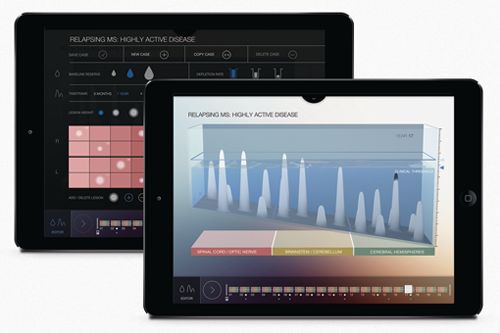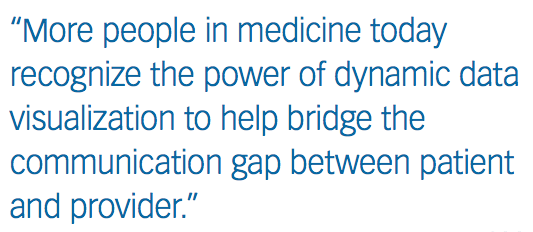Science Meets Art: Mapping the Topography of MS
Pharmaceutical Executive
A new educational and potential prognosis tool for the treatment of multiple sclerosis shows how an accessible, easy-to-see visualization of disease state can serve as the threshold for fresh clinical insight-all geared to the individual patient.
When strict scientific rigor is combined with the visual artistry of data display, something wonderful can occur in the all-too-human practice of medicine. Knowledge becomes accessible-and therefore, useful-in helping healthcare professionals (HCPs) better understand and communicate the clinical manifestations of disease in the individual patient.
Examples of this synergy between art and medicine remain rare, however, which explains why a new collaboration between a prominent academic expert and a leading medical communications agency has attracted the attention of a diverse array of stakeholders active in the study and treatment of multiple sclerosis (MS), a complex, unpredictable and debilitating neurological disorder affecting some 2.5 million patients worldwide.
The project-the “Topographical Model of Multiple Sclerosis” disease simulation app-scored its latest win on March 21, when an independent jury organized by the 4A’s, the top trade association representing the US ad agency business, bestowed its first Health and Wellness Partnering Award to the two collaborators, Dr. Stephen Krieger, assistant professor of neurology from the Icahn School of Medicine at Mount Sinai, and Harrison and Star, the New York-based global healthcare medical communications agency. Christian Bauman, chief creative officer at Health4Brands, and a member of the jury, told Pharm Exec “our recognition of this work demonstrates the appeal of simple visual metaphors that connect the patient directly to his or her condition. Healthcare is the last bastion in advertising where a quick, creative visualization of something inordinately complex carries the most meaning for busy clinicians and their patients.”
The “Topographical Model of MS” is based on research conducted by Krieger, an MS specialist and neurologist at Mount Sinai’s Corrine Dickinson Center for MS. Krieger, a protégé of Center Director Dr. Fred Lublin, who pioneered development of the four clinically accepted phenotypes used to characterize the course of MS in patients, has built on this important definitional work in MS to create a model that visualizes clinical course and disability accumulation in this highly individualized disease.
Krieger sees disease manifestation in individual patients as a continuum, a heterogeneous interplay between relapses and progression that contributes to a variable expression of symptoms and potential disability in MS. This can include motor and/or sensory symptoms, bowel and/or bladder dysfunction, cognitive impairment, fatigue, and depression. The manifestation of these symptoms varies from patient to patient and can be quite unpredictable.
See to believe
According to Krieger, any help in identifying-and thus explaining to patients-the role of underlying lesion topography in the manifestation of symptoms is critical to explicating the disease course of MS in each patient. More broadly, it might guide future improvements in diagnostic accuracy across a spectrum of disease.
In an interview with Pharm Exec, Krieger said he hit upon the idea of a topographical tool to map this condition to address two challenges simultaneously. “One challenge in clinical practice is that it is difficult to

predict the course of MS given the variability of disease factors in each individual patient. It’s an accepted fact that no two patients with MS are precisely alike, so part of the goal behind this tool was to depict disease course in an individualized way. This brought to mind that each patient has a unique underlying disease topography.”
“The second challenge,” Krieger continues, “is the difficulty that clinicians have in relating information about MS disease course to their patients. How can we teach our patients to understand what they are undergoing on a day-to-day basis? Or what they can expect to see next?”
The key to offering more clarity, according to Krieger, is helping patients to understand why it is that some lesions, based on their location and severity, cause relapses and symptoms while others remain hidden, below the “clinical threshold.” Symptoms also manifest differently over the course of the disease. Some result from acute relapses caused by new inflammatory lesions; some occur due to a temporary worsening of symptoms, which can be brought on by stress, infection or fever; while other symptoms reemerge as the disease progresses and can persist as chronic disability. Krieger points out that “understanding the differences in these clinical experiences can help with overall management of MS and to address patients’ emotions, fear and uncertainty that pervades this condition.”
Krieger knew instinctively that accomplishing these two goals depended on rendering information through some type of arresting visual that could capture the attention of patients and initiate an informative dialogue between patients and clinicians. An animated video was his initial thought, the outline of which he sketched out on notebook paper. In presentations to scientific audiences on his research, Krieger also began talking up the need to rethink how clinicians approach patients with MS, empowering them to better understand both the complexity of the disease and their individual goals of care. This, he said, was best advanced through a modeled “map” as a springboard to conversation, adjustable to the individual’s disease topography at a given point in time.
Seatmate summit
Like many collaborations, it was a chance encounter that ended up providing the lift to Krieger’s scribbled sketch notes. Karin Cook, senior vice president and associate creative director for Harrison and Star, happened to find Krieger as her seatmate on a flight returning to New York from a medical meeting on MS in Kansas City. Harrison and Star served as the ongoing creative force behind Teva’s top-selling brand, Copaxone, for 16 years. The two got to chatting and Krieger pulled out his sketch book to describe the concept he was trying to animate.
Says Cook, “My immediate reaction was ‘stopâlistenâlet’s talk’âbecause visualizing complex scientific data is exactly what Harrison and Star does. So we agreed to meet again back in New York when he could look at some examples of our work.”
That discussion quickly produced a consensus that a short video wouldn’t be sufficient to achieve Krieger’s goal of transforming the way clinicians and patients talk about disease progression in MS. “Karin and the Harrison Star team convinced me that to change how patients view this disease we needed a highly interactive app with the capability to visually depict the damage from CNS lesions and relate that directly to the diversity of the disease process in individual patients,” Krieger relates.
Creative test of will
“At Harrison and Star, we saw this as a brain-twisting challenge that would test a lot of our assumptions about the best use of technology,” says Cook. “We wanted to demonstrate that being able to actually interact with a disease could change people’s understanding of it.” In other words, doing good for the MS map was also good for keeping the agency’s creative bona fides fresh.
To implement Krieger’s vision, the agency put together an internal cross-functional team of medical writers specializing in MS, database experts, medical illustrators, 3D imagers, UX designers and digital programmers-all

on a pro bono basis. Development of the prototype for the “Topographical Model of MS” disease simulation app took nine months to complete. As promised, the iPad app (see image at right) presents a visualization of the clinical course of the disease based on the topographical display of disease factors commonly experienced by the individual patient.
A pool and its peaksâ¦
In Krieger’s model, the CNS is depicted as a pool, with a shallow end and a deep end representing increasing functional reserve and the water’s surface denoting the clinical disease threshold. Using 3D imagery to represent key disease factors, the app can show the disease course in MS as having both effects from the base of the pool-with new inflammatory CNS lesions emerging as “peaks”-and also from the surface of the water as functional reserve in the CNS is lost and the clinical threshold declines.
Krieger has spent much of the past year presenting the Topographical Model at grand round talks and professional medical conferences, including an open poster session attended by nearly 500 neurologists at the April 2015 annual meeting of the American Academy of Neurology. The novel hypothesis at the core of this work, that progression recapitulates a patient’s underlying disease topography, is the subject of ongoing academic research.
â¦Leads to more light
Notes Krieger, “The significant thing about the model is it renders the current clinical framework for MS in a sharper light, making it more applicable to the experiences of the individual patient. We are not making new claims about the biology of MS. What the model does is to show the heterogeneity of this disease-and how much of its propensity to cause disability is hidden from view.”
Krieger also cites the novelty of the app devised by the Harrison and Star team. “Using a gaming engine to drive a 3D visual depiction of a disease state as complex as MS was tremendously innovative,” he says. “To my knowledge, it had never been done before in this format, as an educational tool for patients and professionals.”
The best models appear deceptively simple, even when depicting something extraordinarily complex. To achieve this balance, the team translated clinical data for a wide range of disease parameters into pixels and leveraged real-time simulation technology to allow users to vary the severity and rate of these metrics. The spirit of scientific inquiry inspired the team to imagine a future beyond the task before them. Says Cook, “We wanted the app to function for educational purposes as a dynamic visualization; but we also wanted to anticipate how the technology could potentially be used in the future-that someday, once empirically validated, this could be used as a prognostic tool.”
Next steps-and a test run
Until then, a plan to run a demo version of the Model on the iTunes platform is in the works. According to Cook, reaction to the Model’s test run has been solidly supportive. “I think more people in medicine today recognize the power of dynamic data visualization to help bridge the communication gap between patient and provider,” says Cook.
For the advertising community, her message is equally succinct. “As creatives, we hunger to solve big problems, and getting to use technology to

advance scientific thinking has had an electrifying effect on what we know we are capable of doing,” she says. “Working with a creative agency that is steeped in the science behind the disease, inside and out, can really make a difference.”
To Krieger, however, challenges still await. “The science behind this model remains to be empirically validated and peer-reviewed in order for it to become a standard part of MS practice.”
Once that is done-no small feat in itself-the app can be made available to the MS community, empowering patients through a better understanding of their disease with the hope of supporting their treatment goals. But that’s not all. “If the model’s potential is fully realized, my hope is we can actually approach this disease in a way that has real implications for improvement in clinical trial design, recruitment and results,” Krieger predicts.
Time will tell. But thanks to this unique collaboration between a single committed researcher and an agency committed to creative innovation, the outcome is not going to depend on serendipity alone.
William Looneyis Pharm Exec’s Editor-in-Chief. He can be reached at william.looney@ubm.com

The Misinformation Maze: Navigating Public Health in the Digital Age
March 11th 2025Jennifer Butler, chief commercial officer of Pleio, discusses misinformation's threat to public health, where patients are turning for trustworthy health information, the industry's pivot to peer-to-patient strategies to educate patients, and more.
Navigating Distrust: Pharma in the Age of Social Media
February 18th 2025Ian Baer, Founder and CEO of Sooth, discusses how the growing distrust in social media will impact industry marketing strategies and the relationships between pharmaceutical companies and the patients they aim to serve. He also explains dark social, how to combat misinformation, closing the trust gap, and more.